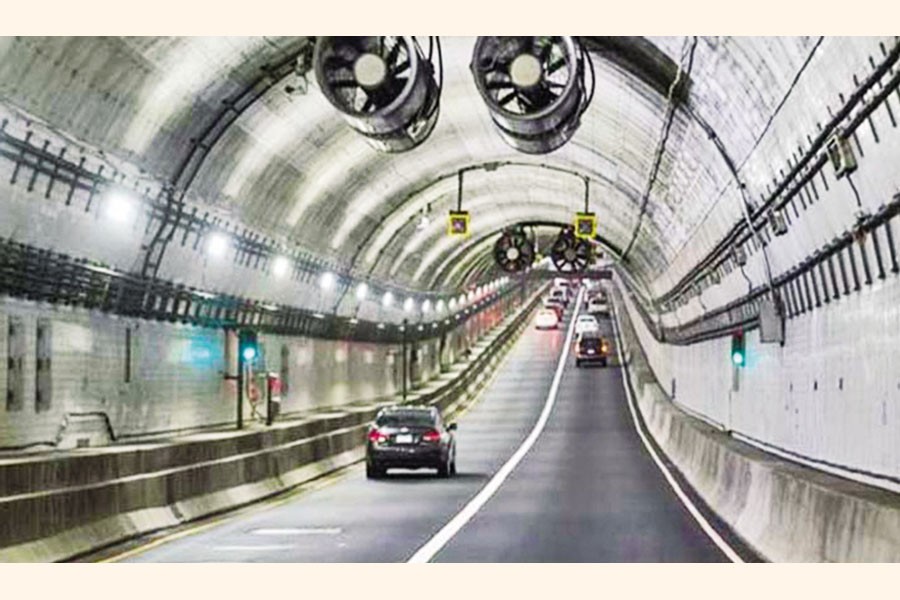
Bangabandhu tunnel ushers in new era in road connectivity
Monday, 8 January 2024

The multilane underwater expressway Bangabandhu tunnel, first of its kind in South Asia, constructed beneath the river Karnaphuli, ushered in new era in road connectivity and elevated Bangladesh into a new level of prominence in the world, reports BSS.
It's a dream come true for millions especially for the residents of commercial capital and port city as the much-anticipated multilane under-river expressway tunnel is expected to turn Chattogram city into "One City, Two Towns" on the model of Chinese city of Shanghai.
It will expand the periphery of the city with boosting economy and opening new doors of immense potentials for industrialisation and expansion of trade and commerce and tourism in the entire region.
Prime Minister Sheikh Hasina opened the Bangabandhu Sheikh Mujibur Rahman Tunnel on October 28 last while it was opened to vehicles from October 29.
Talking to the news agency, Federation of Bangladesh Chambers of Commerce and Industry president Mahbubul Alam said the underwater tunnel is of course a pride for the nation as it is the first road tunnel in South Asia.
Bangabandhu tunnel will boost industrialisation, trade and economy in the region as two export processing zones in Chattogram -- KEPZ in Anwara and Chattogram EPZ in Halishahar -- and Chinese Economic and Industrial Zone (CEIZ) in Anwara will be highly facilitated by the tunnel, he said.
Thus it will have significant contributions to the country's gross domestic product (GDP) like Padma Bridge, he said.
The tunnel will connect the proposed Asian Highway with Dhaka-Chattogram-Cox's Bazar Highway by reducing distance by 40km and it will also facilitate the ongoing and planned power and energy hub in Cox's Bazar, which is already a tourist hub of the country, he mentioned.
Apart from the tunnel, he said, if a Dhaka-Chattogram expressway can be built and a master plan is taken to boost a planned industrialisation on the bank of river Karnaphuli to turn it as a Smart city, it will be highly beneficial for country's economy as well as it can boost Bangladesh's connectivity with 'seven sisters' of India including Mizoram and Manipur expanding trade and business as well as tourism in the region.
Chattogram airport and seaport, Patenga-Anwara link, under-construction bay terminal, Mirsarai Economic Zone, CUFL, Karnaphuli Fertiliser Company Limited, China EPZ, and Cox's Bazar coal power plant have been conveniently accessible via the tunnel and its approach road.
This will simultaneously reduce travel time and costs.
Bangabandhu tunnel has been built at a cost of Tk 103.74 billion (10,374 crore) and of which around half is financed by the Exim Bank of China.
As per the project details, the length of the entire route is 9.39 kilometres (5.83 mi), with the tunnel making up 3.32 kilometres (2.06 mi) of the length while it's diametre is 10.80 metres (35.4 ft).
It has improved the Dhaka-Chattogram-Cox's Bazar highway network. A Chinese company, China Communications Construction Company, constructed it.
Prime Minister Sheikh Hasina and Chinese President Xi Jinping inaugurated the construction site of the Karnaphuli Tunnel on 14 October 2017.
On 24 February 2019, Sheikh Hasina also inaugurated the tunnel boring phase.
The tunnel cuts the road distance between Chattogram and Cox's Bazar and facilitates traffic on Dhaka-Chattogram Highway entering the port city to go to other parts of Chattogram division.
The multilane tunnel route passes through the river close to Navy College on one side and Korean Export Processing Zone (KEPZ) and Karnaphuli Fertiliser Company (KAFCO) on the other.
It connected Chittagong port and Anwara upazila and made communication between Chattogram and Cox's Bazar easier and eased traffic congestion on two bridges over the Karnaphuli River.
Earlier, Road Transport and Bridges Minister Obaidul Quader said the tunnel would help increase the country's annual GDP growth by 0.166pc.
The tunnel is capable of servicing approximately 17,260 vehicles a day equating to some 7.6 million vehicles a year.